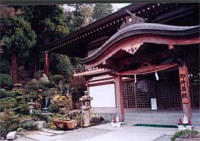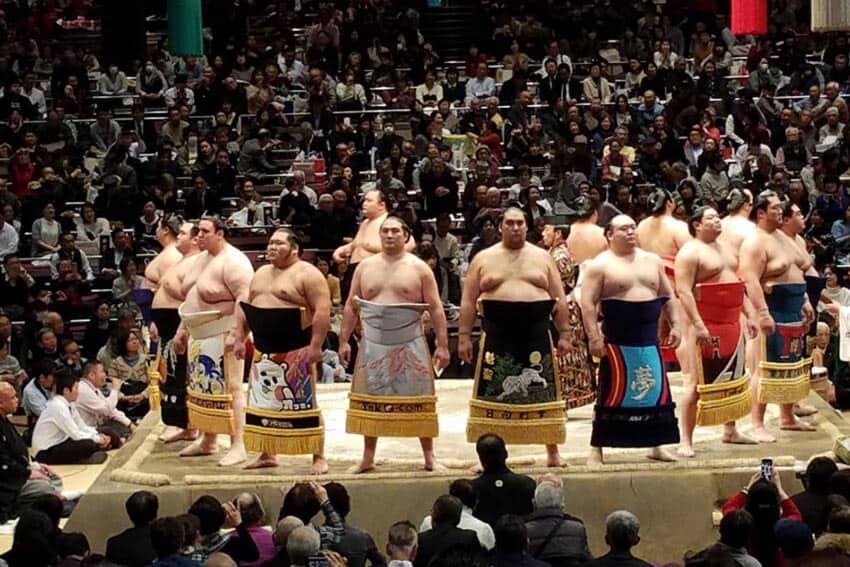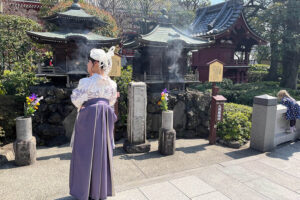
Soft Pedaling the Kibi Plain: Bicycle Explorations of Ancient Japan
By Rick & Chris Millikan

As far back as 400 AD, the narrow Kibi Plain was a significant cultural region.
Soft pedalers now enjoy this historically rich area on a well-marked 15-kilometer bicycle route under the sunniest skies recorded in all of Japan.
Because April can be blustery, my wife and I packed gloves and toques as well as sunglasses to comfortably appreciate this flat, scenic paved path.
Arriving at Bizen Ichinomiya train station from Okayama, we soon found nearby bicycle rentals. We paid a smiling lady two thousand yen, the daily rate for two typically small non-geared bicycles.
Long Flight of Stairs
Patiently explaining to us where we needed to go in enthusiastic but incomprehensible Japanese, she pointed at an inscrutable map and gestured dramatically. So we pedaled down the road, turned right, crossed a railway line, and turned right again, encountering Kibitsuhiko-jinja.
Strolling about this large Shinto Shrine, we eventually sought for further guidance. Besides its large pond stood a road sign confirming our sense of direction. We proceeded onto the designated path along a canal. Caught up in the intriguing scenery and almost missing the turn to Fudenkai-ji, we realized the intersection should be carefully noted. After pausing briefly at this Buddhist temple, we cycled 200 meters further to Kibitsu-jinja at the base of Mt. Naka.
Built in 1425 this Shinto sanctuary was very special. Climbing the long flight of stairs to its glorious hilltop setting, we soon admired the intricately gabled inner and outer shrines, designated as National Treasures. The Shrine’s spacious courtyard also contains a wooden hexagonal serve-yourself oracle issuing English fortunes for 100 Yen. Its six panels depict the popular children’s story of Kibitsuhiko as Peach Boy.

This Shrine’s link with Kibitsuhiko roused our interest. According to historical accounts, the Imperial Court of Yamato dispatched Kibitsuhiko to conquer Kibi Province. Since then the Prince evolved into Japan’s most popular folk hero.
According to Shrine lore, his expedition was commissioned to eliminate a bothersome ogre named “Ura”. Kibitsuhiko camped where Kibitsu-jinja now stands. Watching Shinto priests quietly sweeping the courtyard gravel, we tried to imagine Kibitsuhiko arising to do battle.
The Prince shot menacing arrows. Ura struck these down with mountains of rocks. Then, Kibitsuhiko cleverly shot two arrows at once and hit Ura in the eye. Ura transfigured into a koi, swimming away in a gushing river of blood.
A short pedal further, Koikui-jinja was shimmering in the noonday sun. This Shinto Shrine was where Kibitsuhiko transformed into a cormorant and ultimately captured Ura. Today dappled yellow, orange, white and red koi swim lazy circles in its beautiful pond surrounded by manicured gardens.
Fragrant magnolia, plum and cherry blossoms quivered in the breeze. A fellow visitor clapped his hands sharply, alerting the gods that he and his wife were passing through the vermilion torii gate.
Temples and Shrine Architecture
From there we zigzagged westward along irrigation canals and rice paddies that quilt the valley. Busy roads were glimpsed in the distance, while nearby colorful ducks paddled about and herons stood ready to spear lunch. We passed occasional farmhouses.
Certain aspects reminded us of temple and shrine architecture. Ornate tiled roofs swooped gracefully atop the dark natural wooden structures. Walled residences enclosed groomed garden courtyards. The large sizes, we knew, represented the needs of extended families.
Hunger and thirst added another dimension to our robust adventure. Roadside restaurants are accessible from the trail, yet a picnic seemed simplest and best. We bought Bentos (Japanese box lunches) at Okayama Station and carried them in our bicycles’ large handlebar baskets. A convenient and scenic rest stop was easy to find along the route.
Out of Japan’s countless drink vending machines, we spotted three. At one, while considering Salad Water, Pocari Sweat, and many other exotic options, I bought a tasty cold coffee latte. My wife chose her favorite, Canada Dry.
Our ride soon paralleled a large channel eventually flowing beneath a busy overpass. We emerged beside a large hillock covered with immense stands of bamboo and evergreens. This keyhole-shaped mound entombed a Kibi Lord’s family from the 5th Century. Tsukurlyama-kofun, one of several Kibi burial mounds, measured 350 meters long and 30 meters high, the fourth largest in Japan.
Famed Buddhist Temple
The path soon passed a small community, then wound up and through a woodsy park. A five-story 17th-century pagoda faced us, towering on a hillside above the Kibi plain. Built in the 8th century the famed Buddhist temple, Bitchu Kokobun-ji was commissioned to bring peace in the provinces.
Under blossoming cherry trees, we watched “Hanami” celebrants sipping sake and reclining on colorful blankets. After taking several pictures, we pedaled the few remaining kilometers to Soja.

Nearing the town we paused to investigate a historic Yayoi (storehouse) elevated on posts and complete with rat guards. Then, like the locals cycling their errands, we utilized the narrow streets and sidewalks making our way to the rental drop-off point near Soja station. We immediately boarded a train and soon arrived back in Okayama.
Intriguing Vacation
This soft-pedal added an exuberant, fascinating adventure to an intriguing vacation.
Accessing fifteen ancient sites, the extensive Kibi trail network represents just one of many cycling possibilities in Japan. Ancient Kyoto can also be readily and effectively explored by bicycle rentals. For serious cycling, bring your own bicycle, helmet, tools, lock, and spare parts. Bicycle-friendly Japan awaits your visit.
 Rick Millikan widely publishes cycling adventures, writes a bicycle column for Adventure West and contributed two ‘cycle logical’ stories to an anthology titled Traffic Life.
Rick Millikan widely publishes cycling adventures, writes a bicycle column for Adventure West and contributed two ‘cycle logical’ stories to an anthology titled Traffic Life.
- Montreal’s Breweries Await Your Thirst - May 7, 2024
- Mother’s Day Ideas - May 6, 2024
- Exploring Kenya’s Night Markets - May 3, 2024




